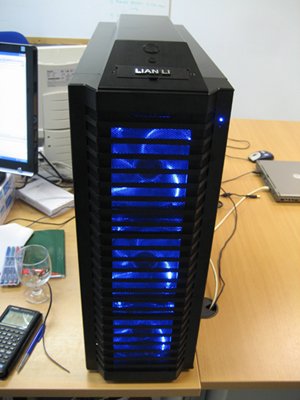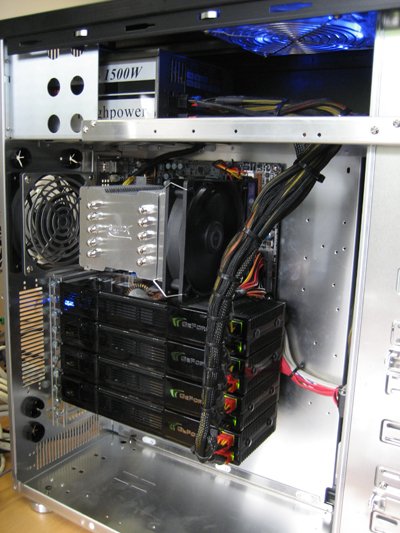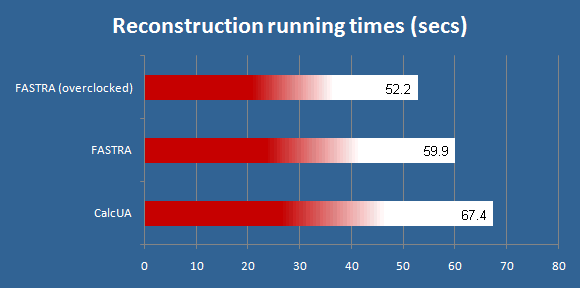
Researchers at the University of Antwerp in Belgium have created a new supercomputer with standard gaming hardware. The system uses four NVIDIA GeForce 9800 GX2 graphics cards, it costs less than 4000EUR to build and thanks to NVIDIA's CUDA technology it delivers roughly the same performance as a supercomputer cluster consisting of hundreds of PCs!
This new system is used by the ASTRA research group, part of the Vision Lab of the University of Antwerp, to develop new computational methods for tomography. The guys explain the eight NVIDIA GPUs deliver the same performance for their work as more than 300 Intel Core 2 Duo 2.4GHz processors. On a normal desktop PC their tomography tasks would take several weeks but on this NVIDIA-based "supercomputer" it only takes a couple of hours. The NVIDIA graphics cards do the job very efficiently and consume a lot less power than a real supercomputer cluster.
The research group ASTRA, part of the Vision Lab of the University of Antwerp, focuses on the development of new computational methods for tomography. Tomography is a technique used in medical scanners to create three-dimensional images of the internal organs of patients, based on a large number of X-ray photos that are acquired over a range of angles. ASTRA develops new reconstruction techniques that lead to better reconstruction quality than classical methods.
Although our reconstruction techniques are very powerful, they have an important drawback: they are quite slow. As the 3D images that we normally deal with can be rather large (typically 1024x1024x1024 volume elements, or more), advanced reconstruction methods can sometimes take weeks of computation time on a normal PC.

Here's a look at the specifications of the FASTRA desktop superPC. The main reason why they configured an AMD system is because they couldn't find a motherboard for the Intel platform that could fit four GeForce 9800 GX2 graphics cards. Another interesting note is that this system doesn't need SLI, their application uses the NVIDIA CUDA programming model which makes all eight GPUs work in parallel. The researchers say they don't need SLI during a reconstruction as every graphics card communicates directly with the CPU, no inter-GPU communication is needed.
A quick note for our American readers, a system with similar specifications would cost you around $3,900 at Newegg. Most computer hardware costs a lot more in Europe than in the U.S.AMD Phenom 9850 processor + Scythe Infinity CPU cooler 4x MSI 9800GX2 graphics card 4x 2GB Corsair Twinx DDR2 PC6400 memory MSI K9A2 Platinum motherboard Samsung Spinpoint F1 750GB HDD ThermalTake Toughpower 1500W Modular PSU Lian-Li PC-P80 Armorsuit case Windows XP 64-bit
The biggest problem of the system is that these four dual-GPU graphics cards are cramped together and generate quite a lot of heat. The FASTRA uses aircooling and with the sidepanel removed the GPUs run at 55 degrees Celsius in idle, 86 degrees Celsius under full load and 100 degrees Celsius under full load with the shaders 20% overclocked. They have to run the system with the left side panel removed as the graphics cards would otherwise overheat but they're looking for a solution for their heat problem.

The medical researchers ran some benchmarks and found that in some cases their 4000EUR desktop superPC outperforms CalcUA, a 256-node supercomputer with dual AMD Opteron 250 2.4GHz chips that cost the University of Antwerp 3.5 million euro in March 2005:

You can read more about the FASTRA GPU SuperPC project over here. The site contains lots of background information, info on the hardware they used, more photos and benchmarks. More videos that explain what the project is all about can be found at YouTube.
In the video below Dr. Joost Batenburg takes you to the ASTRA-lab where he shows what tomographical reconstructions are and what the role of FASTRA is:
Basically the ASTRA researchers have created a very affordable computer system that can perform their tomography work very efficiently. For specific applications that can be massively parallelized GPUs are much faster than CPUs, for the tomography work the NVIDIA-based FASTRA system outperforms a real supercomputer that's much more expensive, takes up more room and uses a lot more power. The Vision Lab is now planning to build a cluster of such systems, which will allow for real-time reconstruction of large 3D volumes. One can only imagine how fast online pokies will render on this beast.
In the future we'll see many more applications that take advantage of the computational power of GPUs to significantly speed up specific tasks. Later this summer NVIDIA will unveil new software that will make HD video transcoding much faster and the firm will also roll out a software update that will add AGEIA PhysX support to all GeForce 8/9 and GeForce GTX 200 series graphics cards. Another application that benefits greatly from GPUs is Folding@Home, ATI GPUs are already supported for quite a while and NVIDIA GPUs will follow soon. Adobe is also playing with GPU acceleration for Photoshop but the firm says this is just an experimental feature that may not be present in the next version of Photoshop.